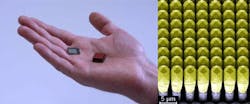Pocket sized x-ray detectors under development in Europe
Engineers working on a European program called Nexray aim to develop pocket-sized x-ray sources and x-ray detectors.
The x-ray sources are based on arrays of multi-wall carbon nanotube (CNT) cold electron emitters. The high current density of such emitters makes it possible to miniaturize an entire x-ray source. Additionally, since the field electron emission of the CNTs are voltage-controlled, they can be modulated at frequencies up to GHz levels.
The x-ray direct detectors, on the other hand, are based on layers of germanium structures built on top of silicon wafers. The method to create such detectors has been perfected by researchers from ETH Zurich (Zurich, Switzerland) and the Centre Suisse d'Electronique et de Microtechnique (CSEM; Neuchatel, Switzerland), in collaboration with their Italian colleagues from the Politecnico di Milano and Universita di Milano-Bicocca.
Dr. Alex Dommann, the Chief Technology Officer at CSEM, believes that by using such emitters and
receivers, engineers would be able to develop miniaturized computer tomography (CT) systems that could be used for monitoring purposes during surgery or to perform fast in-line static product inspection in industry.
A video of Dr. Dommann describing the research efforts can be found on YouTube here, while more written information on the project can be found here.
-- by Dave Wilson, Senior Editor, Vision Systems Design
